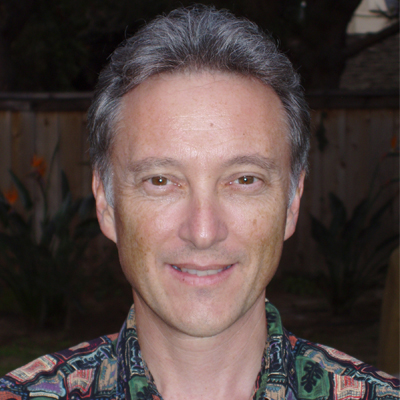Combining physics and biology to understand planktonic ecosystems
Statistically, about half the oxygen we breathe is supplied by the phytoplankton in the ocean, yet we know surprisingly little about these organisms, their interactions, or their environment. Dr. Peter Franks is studying the physical-biological interactions that occur in our world's oceans. Drawing on his training in both the biology and physics of the oceans, he is exploring how physical dynamics such as turbulence, internal waves, fronts and eddies - much like the weather in the terrestrial atmosphere - affect the growth and distribution patterns of plankton in the ocean. The sunlight that drives photosynthesis is only available near the surface of the ocean, while the nutrients that regulate the biomass of the phytoplankton are found mostly in the ocean's depths. The phytoplankton must rely on the physical processes of the ocean to bring critical nutrients from the deep, dark waters up to the surface waters where they can be used for primary production and oxygen production. This intimate coupling between physics and biology controls the spatial and temporal patterns of phytoplankton biomass, primary production, and even fisheries in the ocean. Dr. Franks is researching both the physical mechanisms that control the ocean as well as the phytoplankton ecosystem in order to gain a better understanding of how plankton behave in their natural environment. This, in turn, will provide clues into how planktonic ecosystems will respond to environmental changes.
In terrestrial ecology, primary production is performed by stationary plants. In the ocean, however, fluid motions influence plankton position and the temperature, light, and nutrients of their environment. Studying these forces is critical to understanding how nutrients from the depths of the ocean are moved upward to the photosynthetic plankton that grow at the ocean's surface, where light is plentiful. Dr. Peter Franks, Professor at the Scripps Institution of Oceanography at the University of California, San Diego, and Director of the Integrative Oceanography Division is combining his expertise in physics and biology to understand how the structure and function of planktonic ecosystems change in response to physical forcings, to lead to, for example,
-
the formation of toxic phytoplankton blooms
-
changes in the size structure of the plankton that might lead to a dominance of gelatinous organisms, and
-
changes in ecosystem dynamics that might change the ability of the ocean to sequester, or absorb, atmospheric carbon dioxide.
Changes in the physics of the ocean through warming, changing wind patterns, changing cloud cover, and changing ice cover have immediate and profound effects on the plankton and primary production, or the production of natural chemical energy. Dr. Franks' interdisciplinary training allows him to ask different questions than his more disciplinary colleagues. Using models he develops, Dr. Franks can formulate accurate predictions of patterns of primary production, grazing, infection, or sexual exchange among these simple organisms which are moved so easily by the ocean's currents. His interdisciplinary research is unique and is providing insight into how planktonic ecosystems will respond to global warming, anoxia (oceanic oxygen depletion), acidification, and other perturbations modern human activities are imposing on the oceans. The novel observations he is making are giving way to new theories and models can be used to guide the development of instruments and experiment design, made possible by the convergence of new technologies.
Dr. Franks' current research can be summarized in three steps:
- Developing new instruments to study the physics of the ocean and the behavior of plankton - undisturbed - in the ocean: In instrumentation development with his collaborator Dr. Jules Jaffe, they have invented autonomous underwater explorers (AUEs). These plankton mimics are small yellow cylinders, approximately 1.5 liters in volume, equipped with temperature and pressure sensors. A piston that moves in and out of the device allows them to regulate buoyancy and move vertically in the water column. Dr. Franks can program these devices with specific behaviors, allowing them to move like plankton. They are released in swarms of 20 AUEs that can each be localized within a meter horizontally and a centimeter vertically, generating accurate 3D trajectories of individual drifters over distances of kilometers and time scales of days. He uses an acoustic navigation system to track their individual movements.
- Deploying these new instruments to quantify specific physical dynamics and biological responses in the ocean: Twenty of these devices are deployed as a swarm off the coast of San Diego. A single drifter allows only a limited understanding of the dynamics; with a swarm Dr. Franks can start to accurately see dispersion patterns and movements of these robotic plankton. When programmed to stay at a particular depth, the AUEs reveal the responses of plankton to specific flow patterns inside the ocean. These data have allowed Dr. Franks to test for the first time long-standing hypotheses about plankton accumulation, patch formation, and the statistics of the flow.
-
Designing mathematical and computer models of physical-biological interactions to synthesize the data, and understand and predict the underlying dynamics: The AUE devices are now being used to test the theoretical models Dr. Franks developed throughout his career, but which technological limitations had previously prevented exploring. In 1997, he published a mathematical model which incorporated internal wave physics coupled to a model of simple planktonic swimming behaviors to predict patterns of plankton patchiness in the oceans. His hypothesis predicted that if organisms (plankton) maintained a particular depth by swimming against against the currents formed by internal waves in the ocean, they would accumulate in bands along the wave trough and disperse over the wave crest. The deployed robot swarm was able to provide data that could not previously have been obtained: it is impossible to track the swimming of individual plankton over long distances in the ocean. After waiting nearly 20 years for a suitable technology, Dr. Franks' hypothesis was confirmed with data from the robotic plankton, which are helping usher in a new way of studying the ocean.
Bio
Dr. Peter Franks has always had diverse interests, from science and engineering to music. As early as high school, he began really exploring these passions, looking for a career that would satisfy a large range of his interests, including physics, math, computers, and biology. He enrolled at Queen's University in Ontario, Canada as an undergraduate majoring in physics, but found it a bit boring, so after a short time he switched to biology. While he did enjoy biology, he missed the rigor of physics and math courses, and found himself torn between his two passions. One day, while working at a biology station for his undergraduate thesis research on sparrows, he overheard a colleague mention a program in "oceanography" at Dalhousie University. The only other information Dr. Franks learned was that this program was difficult to gain admittance into. He had been toying with the idea of pursuing marine biology prior to this discussion, but it seemed to be a very common field that would quickly become overpopulated. So, knowing very little about oceanography or what the program entailed, he applied to the Dalhousie program and was accepted.
As fate would have it - serendipitously - the Dalhousie oceanography program was the ideal fit for Dr. Franks. He quickly realized that in order to understand the biology of the ocean, one must first understand the physics, as the fluid state of the ocean is guided by physical forces. In order to gather the information Dr. Franks needed to test his hypotheses, he was required to first develop new instruments capable of performing the actions and processes necessary for data collection. Further, in order to synthesize the diverse types of data collected, he learned to develop new computer models of the physical-biological interactions. Using insights into the physics of the ocean to gain understanding of the dynamics of planktonic ecosystems has been Dr. Franks' driving passion since beginning his career in oceanography. His research incorporates all of his favorite academic pursuits - physics, math, biology and instrument design/computer technology - in a unique and challenging interdisciplinary field. When he began, many of his fields of study were completed in separate projects; Dr. Franks has enjoyed watching all the fields converge as technology and computer models improve.
Dr. Franks is extremely passionate about the work that he does, as very few researchers in the world study the same. When first approaching this research, he was met by critics who told him he could not be an expert in both physics and biology simultaneously. He takes pride in knowing that he is proof that one indeed can. Today, he has one of the best labs at one of the finest oceanography institutions in the world, which is able to recruit extraordinarily bright, hard working and creative graduate students and postdocs. Dr. Franks does not have lab technicians in his lab: all the work is done by his students and postdocs. These young scientists focus on their own research projects, all of which fall under the umbrella of physical-biological interactions. The students' research is focused on their dissertation, which keeps them motivated and productive. Dr. Franks also collaborates a great deal with Dr. Jules Jaffe (also at the Scripps Institution of Oceanography), who runs a lab whose primary goal is to develop new instrumentation for studying organisms in the ocean. He and Dr. Franks work closely on imagining, developing, and deploying novel instruments to improve our ability to understand planktonic ecosystem dynamics in the ocean.
Outside of his lab, Dr. Franks lives a life as diverse as his career. As a child, Dr. Franks had a passion for music and was an accomplished musician and singer, playing both the violin and the classical guitar, and performing as a member of various choirs for several decades. Though music has always been a crucial part of his life, recently his passions lie in fine woodworking. He runs an informal woodworking business on the side, making beds, cabinets, chairs, etc. for his home, as well as the homes of friends. He operates under the slogan, "I'm slow, but I'm expensive," giving testament to his craftsmanship. He jokes that his oceanography career keeps him supplied in tools, and is determined to use them all in various ways.
When not working or building, Dr. Franks finds himself enjoying the many treasures of the culinary world. He and his wife alternate cooking meals, and he is an accomplished pasta maker. He is on a lifelong quest to find the perfect noodle, traveling around the world and sampling noodle dishes as he goes; currently Dr. Franks is enamored with ramen and udon noodles from Japan. He is a dilettante of fine wines, which pair ideally with noodles of any culture. To counter his culinary enjoyments, he takes his "personal trainer," a lovely golden retriever, walking through the hills of his neighborhood or to hospitals as a therapy dog for easing patients.
In the News
National Science Foundation


